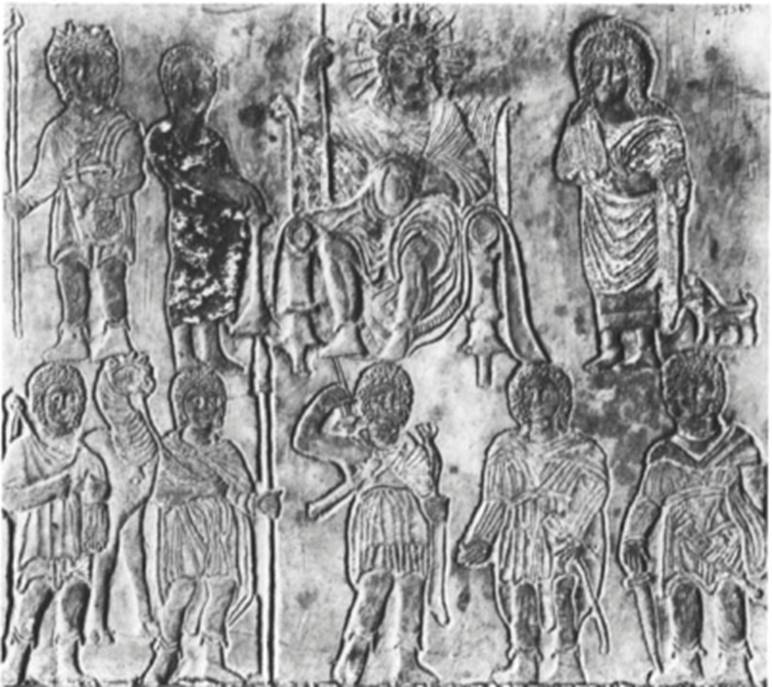Relief with an emperor as Helios enthroned. Egypt, 2nd-3rd century. Painted limestone
More a colored, incised drawing than a sculpted relief, this well-preserved limestone slab still retains some of its original paint, especially on the figure of the emperor: red flesh, red and blue drapery, black boots, black hair, yellow crown.
The yellow of the camel is also well preserved. Each figure is set within, and slightly apart from, an enclosing contour, seemingly placed below the surface of the stone in a crude adaptation of the ancient Egyptian technique of recessed relief. Despite the rudimentary technique, the stocky proportions, and a tendency toward frontality— each figure is fully defined on an implied groundline, distinguishing elements of costume are precisely indicated, and vestiges of classical poses have been maintained. This combination of Egyptian and Hellenic motifs, organized by a naive, hieratic composition, is difficult to date on grounds of style but seems closest to those works produced in other mixed cultural contexts in Egypt in the early Severan period.

Iconographically, this relief participates in the varied program of monuments of a quasireligious character employed by units of the Roman army. Such works of art invoke the numinous presence of the emperor as a symbol of their allegiance and for their protection.
On the bottom appears a line of Roman soldiers dressed in short tunics with mantles, boots, and various weapons. The soldier in the center carries a bow and quiver on his back in addition to a dagger under his arm and holds some unidentified object in his left hand. The two soldiers at the far left control a camel, probably as indication that the unit is an auxiliary force of dromedarii detached for service in Egypt to protect the caravans from desert raiders (see Lesquier, 1918, pp. 113-114). On the upper row and clearly more important, from left to right there appear an officer (centurion?), a baton in his left hand and a standard (?) in his right; then a short-haired priest in a long, painted robe, wearing sandals, and with his right hand extended over a thymi- aterion; at the far right another mantled figure with long, curly hair, holding a plant (?) symbol in his left hand and a dog on a leash.
The enthroned figure of a Roman emperor dominates the entire composition; he displays a spear in his right hand as a symbol of military-political power, is nimbed and radiate, and wears both a fillet and on top the Egyptian hem-hem crown, attributes of a ruler. The rays and nimbus are signs of Sol. or Helios to whom Roman emperors assimilated, especially in the third century, when solar attributes contributed to the imagery of invincibility. Although the head is too generalized for identification and has, if anything, a vague resemblance to portraits of Alexander the Great, it is conceivable that Caracalla is here represented in all his glory.
Said to come from Cairo or Saqqara. Bibliography: Edgar, 1903, p. 55, pi. xxv; Giglioli, 1938, p. 722, no. lix.57.
Date added: 2025-07-10; views: 42;
